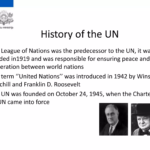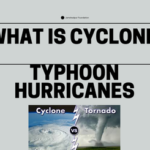How climate change fuels tropical cyclones:Basics Explained

Warming of the surface ocean from anthropogenic (human-induced) climate change is likely fuelling more powerful Tropical Cyclone (TC). The destructive power of individual TCs through flooding is amplified by rising sea level. In addition, TC precipitation rates are projected to increase due to enhanced atmospheric moisture associated with anthropogenic global warming.
Hurricanes are becoming wetter, windier, and generally more powerful as a result of climate change and additionally, it is making storms move more slowly, allowing them to dump more water in one location.
Climate change would have caused the earth to become much hotter if it weren’t for the oceans. However, over the past 40 years, the ocean has absorbed 90% of the warming brought on by emissions of heat-trapping greenhouse gases. Near the water’s surface, the majority of this ocean heat is concentrated. Stronger winds and increased storm severity may result from this added heat. A storm’s ability to produce more rainfall can increase due to climate change. A warmer environment can store more moisture; thus water vapour accumulates until clouds form and raindrops are released, sending down heavy rain
As with any storm, they develop when drastically different air masses clash — typically, cold and dry air moving down from the north and warm, moist air coming up from the tropics. The warmer air rapidly rises, creating cloud systems, lowering air pressure and developing into a storm system that circulates counter clockwise around that center of low pressure.
Rapid storm strengthening is a signal that increasing amounts of warm air are being drawn into a storm’s circulation, spiraling toward its center and rising out its top. When more air escapes out the top of the storm than is being sucked inward, air pressure drops even further.
These large storms have varied names based on where and how they formed, although theoretically being the same phenomenon.
When storms that develop over the Atlantic Ocean or the central and eastern North Pacific attain wind speeds of at least 74 miles per hour, they are referred to be “hurricanes” (119 kilometres per hour). They are referred to be “tropical storms” up until that moment.
Typhoons in East Asia are the name given to ferocious, spinning storms that develop over the Northwest Pacific, while “cyclones” develop across the Indian Ocean and South Pacific.
Hurricanes, cyclones, and typhoons are all the same weather phenomenon. In the Atlantic and Northeast Pacific, the term “hurricane” is used.
The same type of disturbance in the Northwest Pacific is called a “typhoon” and “cyclones” occur in the South Pacific and Indian Ocean.
The ingredients for these storms include a pre-existing weather disturbance, warm tropical oceans, moisture, and relatively light winds. If the right conditions persist long enough, they can combine to produce the violent winds, incredible waves, torrential rains, and floods associate with this phenomenon.
It is characterized by a large scale closed circulation system in the atmosphere which combines low pressure and strong winds that rotate counter-clockwise in the northern hemisphere and clockwise in the southern hemisphere.
Further warming will likely lead to an increased proportion of TCs of higher severity (category 4 & 5) with more damaging wind speeds, higher storm inundation, and more extreme rainfall rates.
A bomb cyclone is a mid-latitude storm whose central air pressure falls at a rate of one millibar per hour for at least 24 hours.
READ: Here’s what’s known about how climate change fuels tropical cyclones – The Hindu
When storms that develop
over the Atlantic Ocean or the central and eastern North Pacific attain wind
speeds of at least 74 miles per hour, they are referred to be “hurricanes” (119 kilometres per hour). They are
referred to be “tropical storms” up until that moment.
Typhoons in
East Asia are the name given to ferocious, spinning storms that
develop over the Northwest Pacific, while “cyclones” develop
across the Indian Ocean and South Pacific.
Hurricanes, cyclones,
and typhoons are all the same weather phenomenon. In the Atlantic
and Northeast Pacific, the term “hurricane” is used.
The same type of
disturbance in the Northwest Pacific is called a “typhoon” and
“cyclones” occur in the South Pacific and Indian
Ocean.
The ingredients for these storms include a pre-existing weather
disturbance, warm tropical oceans, moisture, and relatively light
winds. If the right conditions persist long enough, they can combine
to produce the violent winds, incredible waves, torrential rains, and floods
associate with this phenomenon.
It is characterized by
a large scale closed circulation system in
the atmosphere which combines low pressure and
strong winds that rotate counter-clockwise in
the northern hemisphere and clockwise
in the southern hemisphere.
Further warming
will likely lead to an increased proportion of TCs of higher severity (category
4 & 5) with more damaging wind speeds, higher storm inundation, and more
extreme rainfall rates.
A bomb cyclone is a
mid-latitude storm whose central air pressure falls at a rate of one millibar
per hour for at least 24 hours.
READ: Here’s
what’s known about how climate change fuels tropical cyclones – The Hindu
When storms that develop
over the Atlantic Ocean or the central and eastern North Pacific attain wind
speeds of at least 74 miles per hour, they are referred to be “hurricanes” (119 kilometres per hour). They are
referred to be “tropical storms” up until that moment.
Typhoons in
East Asia are the name given to ferocious, spinning storms that
develop over the Northwest Pacific, while “cyclones” develop
across the Indian Ocean and South Pacific.
Hurricanes, cyclones,
and typhoons are all the same weather phenomenon. In the Atlantic
and Northeast Pacific, the term “hurricane” is used.
The same type of
disturbance in the Northwest Pacific is called a “typhoon” and
“cyclones” occur in the South Pacific and Indian
Ocean.
The ingredients for these storms include a pre-existing weather
disturbance, warm tropical oceans, moisture, and relatively light
winds. If the right conditions persist long enough, they can combine
to produce the violent winds, incredible waves, torrential rains, and floods
associate with this phenomenon.
It is characterized by
a large scale closed circulation system in
the atmosphere which combines low pressure and
strong winds that rotate counter-clockwise in
the northern hemisphere and clockwise
in the southern hemisphere.
Further warming
will likely lead to an increased proportion of TCs of higher severity (category
4 & 5) with more damaging wind speeds, higher storm inundation, and more
extreme rainfall rates.
A bomb cyclone is a
mid-latitude storm whose central air pressure falls at a rate of one millibar
per hour for at least 24 hours.
READ: Here’s
what’s known about how climate change fuels tropical cyclones – The Hindu
When storms that develop
over the Atlantic Ocean or the central and eastern North Pacific attain wind
speeds of at least 74 miles per hour, they are referred to be “hurricanes” (119 kilometres per hour). They are
referred to be “tropical storms” up until that moment.
Typhoons in
East Asia are the name given to ferocious, spinning storms that
develop over the Northwest Pacific, while “cyclones” develop
across the Indian Ocean and South Pacific.
Hurricanes, cyclones,
and typhoons are all the same weather phenomenon. In the Atlantic
and Northeast Pacific, the term “hurricane” is used.
The same type of
disturbance in the Northwest Pacific is called a “typhoon” and
“cyclones” occur in the South Pacific and Indian
Ocean.
The ingredients for these storms include a pre-existing weather
disturbance, warm tropical oceans, moisture, and relatively light
winds. If the right conditions persist long enough, they can combine
to produce the violent winds, incredible waves, torrential rains, and floods
associate with this phenomenon.
It is characterized by
a large scale closed circulation system in
the atmosphere which combines low pressure and
strong winds that rotate counter-clockwise in
the northern hemisphere and clockwise
in the southern hemisphere.
Further warming
will likely lead to an increased proportion of TCs of higher severity (category
4 & 5) with more damaging wind speeds, higher storm inundation, and more
extreme rainfall rates.
A bomb cyclone is a
mid-latitude storm whose central air pressure falls at a rate of one millibar
per hour for at least 24 hours.
READ: Here’s
what’s known about how climate change fuels tropical cyclones – The Hindu





0 Comments